
The Great AI Awareness Divide: Who’s in the Know?
May 6, 2025Generative AI isn’t just a buzzword anymore—it’s becoming part of people’s everyday digital routines. From well-known names like ChatGPT to emerging platforms like Claude and Grok, adoption is gaining momentum across a diverse set of users. In this second installment of our generative AI series, we shift from awareness to action, examining which tools people are actually using in the past 30 days.
Let’s jump in:
Overall
Overall, ChatGPT leads in usage with 44% of respondents saying they’ve used it in the past 30 days. Gemini follows at 30%, and Copilot comes in at 17%. Emerging platforms, like Claude, Grok, Perplexity, and Duet remain under 10% usage each. Still, a significant 34% of respondents indicated they hadn’t used any of the listed AI tools recently.
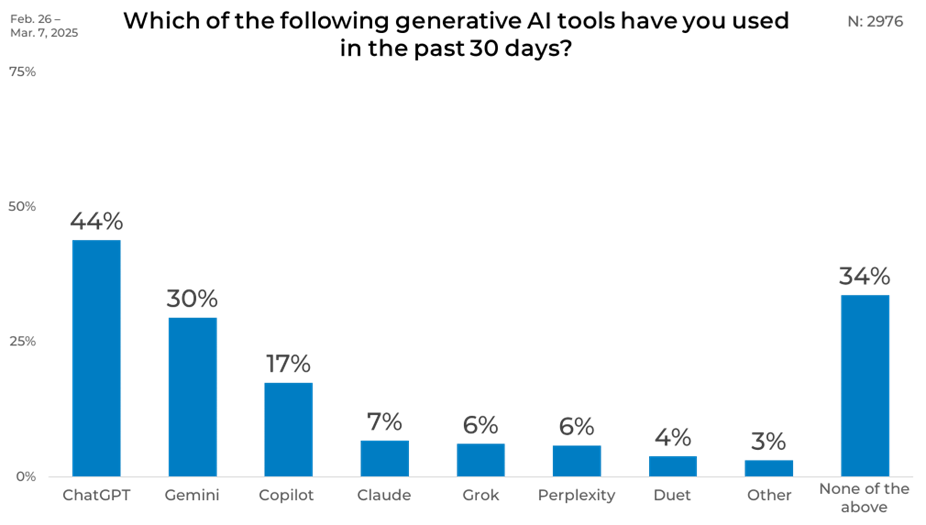
Usage Changes Over Time
We have observed generative AI usage steadily increase over the last four waves of our research-on-research. ChatGPT’s usage increased 15 points, from 29% in Wave 1 (April 2024) to 44% in Wave 4 (March 2025). Gemini’s growth was even steeper, climbing from just 9% in Wave 1 to 30% in Wave 4. Copilot also saw consistent gains, more than doubling its usage across the waves. In contrast, the proportion of users who hadn’t tried any tools dropped 15 points.
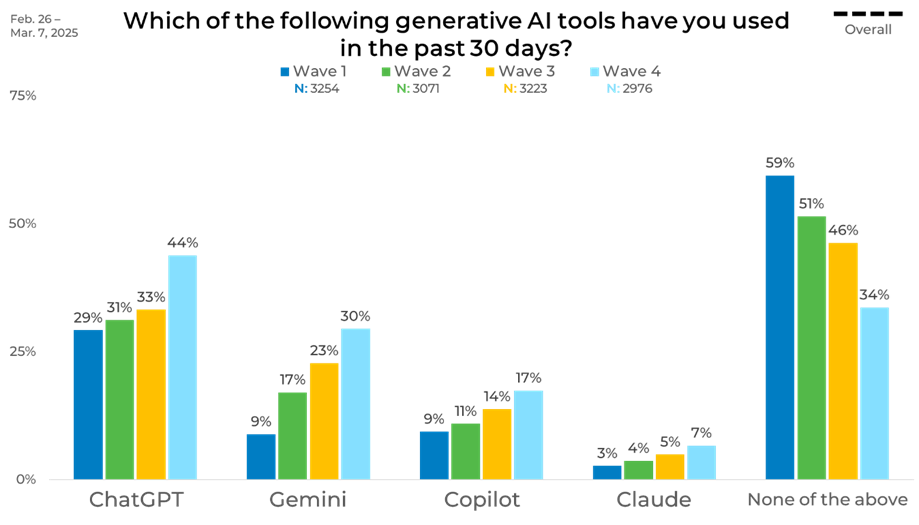
Gender
Men are more likely to use generative AI tools than women. Half of male respondents reported using ChatGPT recently, compared to 38% of women. Gemini and Copilot also saw stronger engagement from men, at 36% and 22% respectively, versus 23% and 13% among women. Notably, 40% of women reported no usage of any AI tools, compared to just 27% of men.
The same gender divide is reflected in the use of other generative AI tools as well. Claude, for example, saw modest engagement across both groups but remained more popular with men (8%) than women (5%). Across all tools, men showed higher levels of interaction and lower rates of non-participation, underlining a consistent pattern of male-led engagement in this digital space.

Age
Age plays a more impactful role in gen AI usage patterns. ChatGPT usage is highest among younger users, with 59% of those aged 18-24 and 56% of those 25-34 reporting recent usage. Usage drops with age, falling to just 21% among those 65 and older. Likewise, non-usage climbs with age: 20% of 18-24-year-olds haven’t used any tools, compared to 64% of seniors.
Other tools show similar age-related trends. Claude sees its strongest usage among those 25-34 at 13%, while dropping to zero among users 65 and older. Gemini and Copilot follow a comparable trajectory, with higher engagement among younger adults.
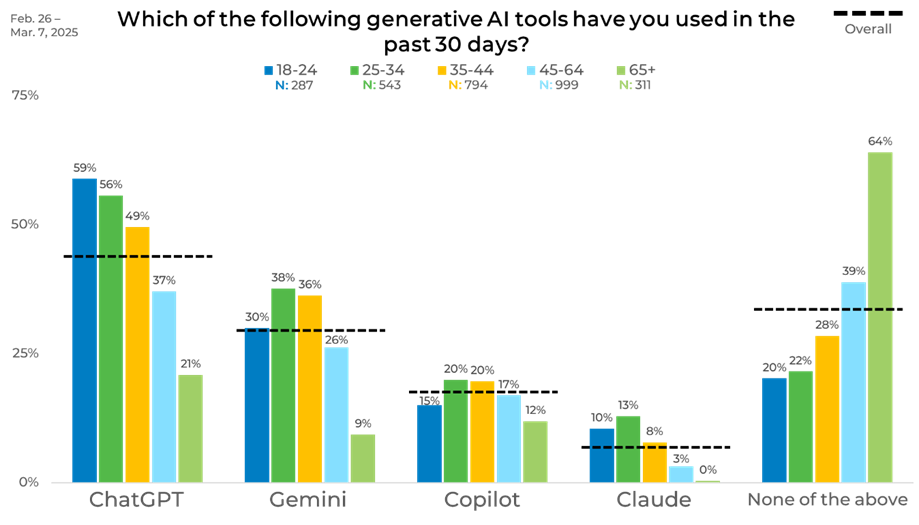
Income
Income level also strongly correlates with generative AI tool usage. Those earning over $100,000 reported 62% usage of ChatGPT, compared to just 27% of respondents with incomes under $20,000. Gemini and Copilot follow similar patterns, with higher-income individuals showing greater usage across the board. Meanwhile, non-usage drops from 43% in the lowest income bracket to 23% in the highest.
Even the lesser-used tools reflect income-based trends. Claude saw 10% usage among those earning over $100,000, compared to 6% or lower in lower brackets. Across all tools, higher income groups reported more frequent engagement, likely tied to access, awareness, or occupational exposure to digital tools. The relationship between income and tech use remains a defining factor in adoption trends.
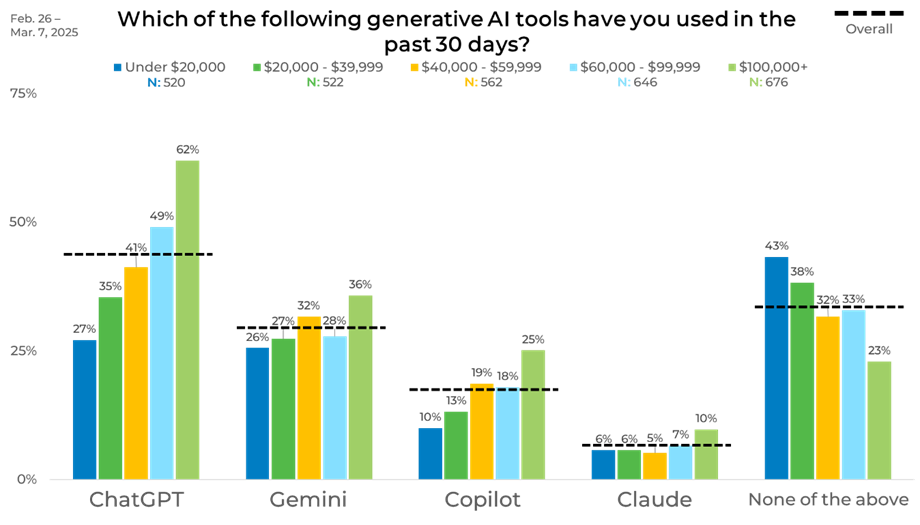
Ethnicity
Ethnicity also factors into how people use generative AI tools. Hispanic/Latino (54%) and Asian or South Asian (53%) respondents reported the highest ChatGPT usage, with African American respondents close behind at 46%. Caucasians reported 42% usage, while the ‘Other’ ethnic category had the lowest at 31%. Non-usage was highest among the ‘Other’ category (38%) and Caucasians (36%), signaling variation in familiarity and access. Gemini was used by about a third of African American and Hispanic/Latino respondents, compared to 28% of Caucasians.
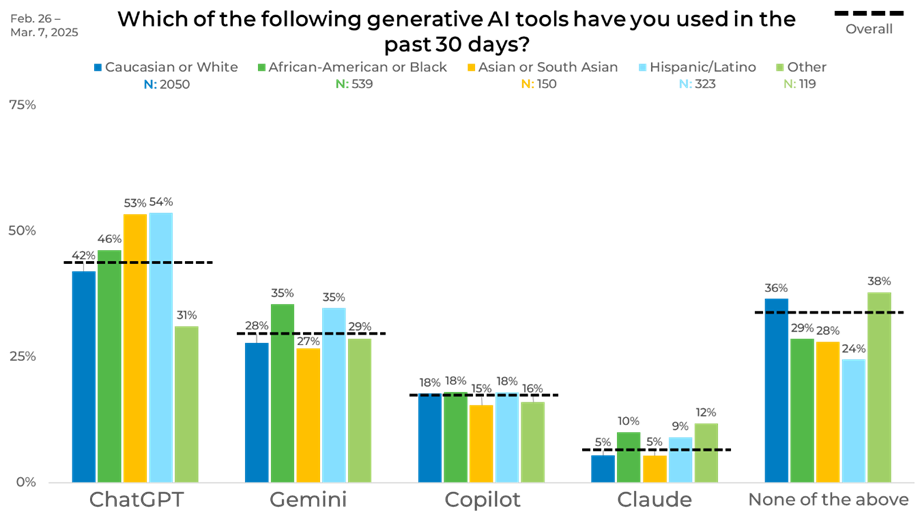
Panel
Panel results varied widely, underscoring the risks of relying on a single source. ChatGPT usage, for example, ranged from 31% in Panel C to 69% in Panel P—a 38-point spread. Non-usage spanned from just 13% in Panel P to 41% in Panel I. Similar gaps appeared with other tools: Gemini saw a 15-point difference between Panel P (41%) and Panel I (26%).
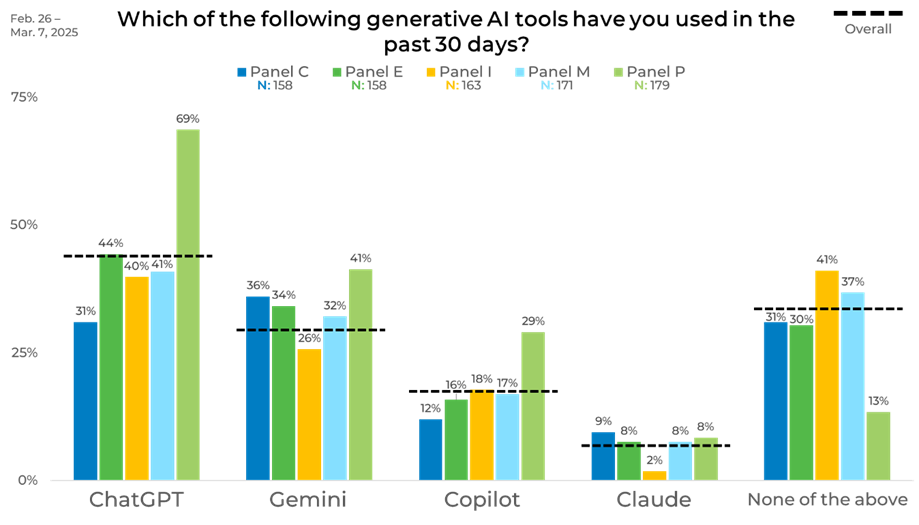
The differences we have observed highlight why strategically blending panels is a best practice to obtain a more reliable and balanced view on consumer attitudes. Click the button below to learn more about our strategic sample blending approach.




